Rene has organized projects in Belarus, Cuba and Azerbaijan dedicated to political design. He is the founder, curator and organizer of Poland’s first graphic design festival, the Graphic Knowledge Fair. He founded (together with the critic Agata Szydłowska) the Design Criticism Studio – the first Polish think tank devoted to design culture in Central Europe.
We were already very happy to have Rene on board TYPO Berlin 2013 before we sent him a few questions regarding this year’s Design Special on Poland to introduce the topic. Now that we have received his answers we are even more looking forward to meet him and the speakers he selected to talk at TYPO 2013!
Q: In brief – what distinguishes polish design?
This is a difficult question because we’re at a crucial turning point right now when contemporary Polish design is experiencing a rapid transformation, and it’s still not clear where it’s going to lead.
Polish design is definitely innovative and on a world-class level. A good example is Jacek Utko, an outstanding designer working very successfully in about a dozen Central and Eastern Europe countries on projects connected with the transformation of the press from print to the digital realm. At the same time, Polish designers are searching for a new local identity in the less obvious history of visual culture. An excellent illustration of this trend is Marian Misiak’s realization concerning the most futuristic but most forgotten Polish typeface from the 1970s – NewZelek.
An example is the brilliant publishing activity of Honza Zamojski, who conquered the Polish art world a few years ago. All of these trends contain the tension between Poland’s world-renowned poster tradition and the need to keep up-to-date with the current global trends and styles. This tension can particularly be seen in the career of Grzegorz Laszuk – a radical political and theater activist who began many years ago as an amateur creating progressive fonts that broke away completely from the Polish poster tradition and who has now, oddly, become a classic of this branch of design in Poland. The tension between this intense gaze into the past and contemporary challenges, between the desire to follow artistic ambitions and the need for practicality, between the obligation to follow the Polish poster tradition and the constraints of advertising and marketing, between the desire to be in synch with global trends and styles and the need to find one’s own local visual language – all of these dichotomies characterize Polish design today, in the year 2013.
However, it’s necessary to add that none of this is completely specific or coherent, but is rather a dynamic process which is taking place in front of our eyes. During our appearance at Typo we will attempt to capture the present moment and describe what this “new” Polish design is like, or soon will be.
Q: Are there traditions it goes back to?
Yes, Polish designers make reference to tradition, but often in a very non-obvious and sur-prising way. For example, they mix artistic traditions of the 1920s with pop culture from Communist times. They join solutions from the “Polish School of Posters” with visual scraps from the turbo-capitalism of the 1990s. They always keep up with global design trends. They have one foot in history and the tradition of the Polish poster, and the other in Swiss-Dutch inspirations and the freshest worldwide styles. They look through the newest designs on the trendlist.org website as intensively as books on graphic design in Communist Europe in the 1960s.
A great example of this type of approach is the PanTuNieStał clothing company.
Running a niche blog, as a hobby, about the forgotten and rejected pop culture of Communist Poland linked with the American retro style resulted in the creation of a cult alternative fashion brand and commercial success for its founders.

Rene Wawrzkiewicz
I think that these diverse interests in tradition are connected to a search for one’s own local visual language. After the fall of Communism, for many years we “chased” Western Europe and the world, but finally now we’re “from here,” and designers are beginning to ask themselves fundamental questions: Where exactly am I from? What is my “authentic,” “native” style?
An excellent introduction to this universal question will be two lectures: the inaugural lecture on Saturday given by design critic Agata Szydłowska on the topic of contemporary design, considering whether Polish designers are hipsters or patriots, and the closing speech by Piotr Rypson on the complicated roots of every culture’s visual identity.
Q: Can polish design be considered as contemporary witness of the change in polish politics and society?
Definitely. Designers always work within a specific reality and are a reflection of social and political orders. In Poland, design culture experienced a drastic economic and technological revolution during a very short time. Everything completely changed. Designers were not only witnesses, but also actively took part in these transformations.
Stated more simply, one can say that during the Communist era graphic designers were artists. There didn’t exist a feasible market or consumers, and thus ambitious artistic designs were created and accepted by the state. At the same time, the technological backwardness and lack of means resulted in designs being realized one copy at a time, or else they ended up looking different than the designer had intended. Both literally and figuratively speaking, it was art for art’s sake.
The fall of Communism and the technological revolution caused a literal disappearance of an entire generation of graphic designers. Capitalism came and the advertisement dominated everything and everyone.
Around the year 2000, companies gradually began to be established realizing graphic design (for example branding) within the field of advertising. During the past few years this process has accelerated, many small and medium-sized design studies have been founded, and many characteristic designers have appeared as well as large numbers of very interesting and truly useful designs.
Based on Poland’s example, it’s possible to see that design is, in its form and function, always a mirror reflection of social evolution. Design is a way for people to communicate with each other and organize space according to specific economic and social needs.
Q: How did the change from socialism to post-capitalism affect the design industry?
The Polish designer is an artist who used to work in advertising but now, after being made “unemployed” by the economic crisis, has once again become an artisan and is beginning to ask himself questions about the definition and purpose of design.
It’s interesting that the word “design” didn’t exist in the Polish language until recently. We have various words for particular areas of design. Symbolically, one can say that since 1989 we have been constantly seeking a Polish meaning of the word “design.” We already know that it’s not art, and it’s not advertising. We also suspect that perhaps in Eastern Europe design is something different than what it is in the West …
The situation in Poland is fascinating because we have many talented designers, an excellent tradition, a great deal of knowledge, new technical possibilities, growing financial means and many things yet to accomplish. And also, perhaps most importantly, possibilities for experimentation!
Q: Is there an institution or a network to turn to concerning information on polish design and polish designers?
Unfortunately, in Poland there currently exists no single institution involved comprehensively in design, but it is necessary to point out a few interesting local places: the BWA design gallery in Wrocław, the Zamek Cieszyn center of design in Silesia, and the Poster Museum in Warsaw.
Among websites and blogs I would definitely recommend the webpage for the “Design of the Year” competition, which annually awards the most interesting and important graphic designs in Poland, the Printcontrol blog dedicated to the most fashionable young design, the Bęc Zmiana Foundation’s webpage which contains up-to-date descriptions of what is happening in art, architecture and design, and the website of Illo, Poland’s first illustrators’ agency.
Among webpages, others that deserve attention are the website of the Association of Applied Graphic Designers and 2+3D magazine. Unfortunately, both of these are almost entirely in Polish. But, on the positive side, in May there will be a launch of 2+3D magazine on iPad with an English-language version intended especially for international readers.
For those who wish to see firsthand what is happening in Poland, I recommend coming to Poland’s largest design festival, the Łódź Design Festival and the Graphic Knowledge Fair in Warsaw, or following what is happening in the new, experimental school of design in Poznań, the School Of Form.
Q: Are there exchange initiatives between German and Polish designers?
It seems to me that contact between Polish and German designers is irregular, sporadic, and, unfortunately, quite random. Knowledge of each other is rather superficial and stereotypical. In Germany, Polish graphic art constantly remains the “Polish School of Posters,” which in fact ended in the 1970s and doesn’t have much in common with the present. Knowledge of German design in Poland is rather poor.
Everything is slowly changing, particularly during the past few years, thanks to (among other things) the activities of Michael Okraj from Designerdeutsch, as well as the editorial staff of Novum magazine. And this year there will be a huge turning point thanks to the presentation of Polish design at DMY, in the display of new Polish illustration at Illustrative (which I am organizing together with Agata Nowicka and Maria Zalewska), and, of course, above all, at the TYPO Berlin 2013 conference!











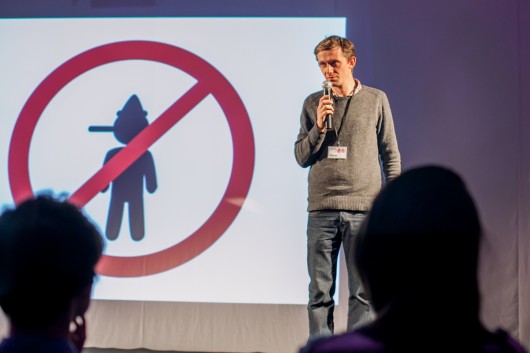
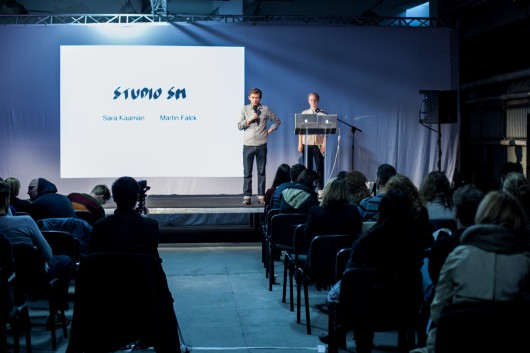 Rene Wawrzkiewicz on stage at the Graphic Knowledge Fair in Warsaw, he organized in October 2012. An innovative educational formula, which combines individual consultations with professional designers with a series of events meant for a wide public.
Rene Wawrzkiewicz on stage at the Graphic Knowledge Fair in Warsaw, he organized in October 2012. An innovative educational formula, which combines individual consultations with professional designers with a series of events meant for a wide public. 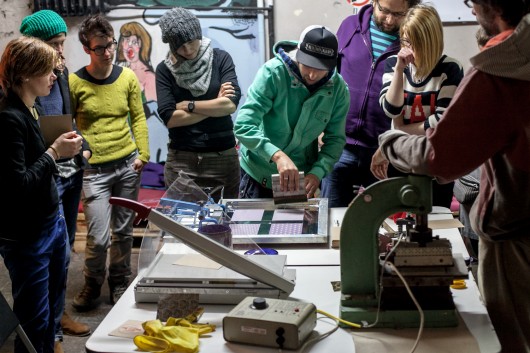 Hands on side programm at the Graphic Knowledge Fair 2012 that took place outside the institutional framework and school environment and was accessible for all who fancy graphic design, demonstrating how much graphic design is interwoven with polish youth culture.
Hands on side programm at the Graphic Knowledge Fair 2012 that took place outside the institutional framework and school environment and was accessible for all who fancy graphic design, demonstrating how much graphic design is interwoven with polish youth culture.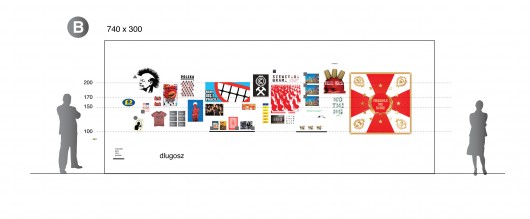 Design for Freedom — Freedom In Design was an exhibition and research project that focused on Polish design of the last 30 years, during the system transformation in Poland covering the period from socialism to post capitalism. Curators: Agata Szydłowska and Rene Wawrzkiewicz. The photograpgh shows the hanging plan for one of the walls.
Design for Freedom — Freedom In Design was an exhibition and research project that focused on Polish design of the last 30 years, during the system transformation in Poland covering the period from socialism to post capitalism. Curators: Agata Szydłowska and Rene Wawrzkiewicz. The photograpgh shows the hanging plan for one of the walls.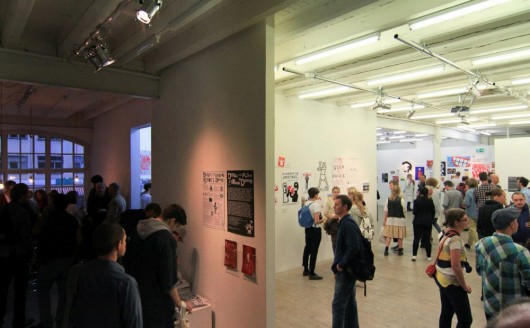 Design For Freedom — Freedom In Design toured the world from 2010 till 2012 and has been shown in Japan, Germany and Sweden. The photograph shows the exhibition in Stockholm, where it uncovered the hidden and surprising connections and parallels between Polish and Swedish design.
Design For Freedom — Freedom In Design toured the world from 2010 till 2012 and has been shown in Japan, Germany and Sweden. The photograph shows the exhibition in Stockholm, where it uncovered the hidden and surprising connections and parallels between Polish and Swedish design. “Design of the Year — a Polish Graphic Design Competition”: “>Each year a specially appointed jury selects the best, most intriguing and most ground-breaking projects. The jury works together with a group of researchers from all over Poland who gather information throughout the year concerning the most interesting projects from all fields of graphic design, from all over the country.
“Design of the Year — a Polish Graphic Design Competition”: “>Each year a specially appointed jury selects the best, most intriguing and most ground-breaking projects. The jury works together with a group of researchers from all over Poland who gather information throughout the year concerning the most interesting projects from all fields of graphic design, from all over the country.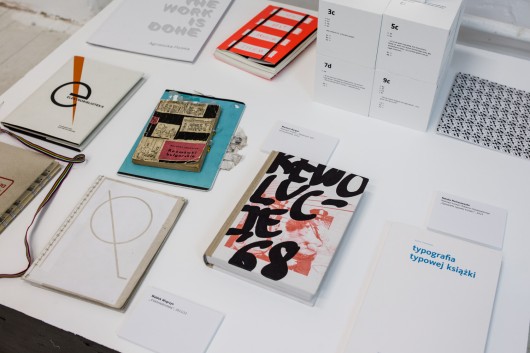 “Design of the Year — a Polish Graphic Design Competition” is the very first graphic design competition in Poland to present the most interesting projects created by Polish designers while also inspiring reflection on the function of design and the social responsibility of designers. Rene Wawrzkiewicz is member of last years jury.
“Design of the Year — a Polish Graphic Design Competition” is the very first graphic design competition in Poland to present the most interesting projects created by Polish designers while also inspiring reflection on the function of design and the social responsibility of designers. Rene Wawrzkiewicz is member of last years jury.









